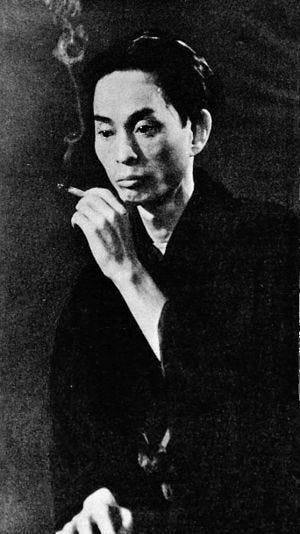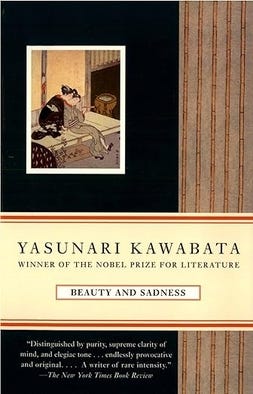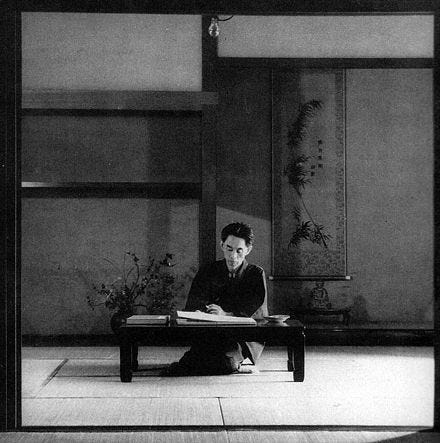Years ago I read Kawabata’s Snow Country - doable in an afternoon - and found the whole thing mesmerising: recognisable but odd, like an oil portrait painted on silver. His much later novel, Beauty and Sadness, is as ethereal and as odd but, I think, more conventional in narrative. I have just finished reading it.
Beauty and Sadness is, like the Kyoto gardens that frame its setting, a work of acute aesthetic precision. Kawabata, master of the unsaid, of delicate insinuation, rarely gets to overt drama: the closing paragraphs are probably the only exception. Instead, it’s quiet contemplation: memory, desire and revenge are explored with restraint. Beneath the surface elegance, however, there is a meditation on power, time, and the irreversible consequences of action.
At the heart of Beauty and Sadness is, unsurprisingly, the relationship between beauty and sorrow, which are not, Kawabata suggests, merely connected but mutually dependent. As the title intimates, to experience beauty is to court sadness. Mono no aware, the awareness of the impermanence of things - and so often beautiful things - is a touchstone of Japanese aesthetic; as Donald Richie put it in A Tractate on Japanese Aesthetics, mono no aware is “a kind of content resignation, an observance of the way things are and a willingness to go along with them.” It involves "experiencing the basic nature of existence, savoring the comforts of being in harmony with the cycles of the universe, and acceptance of adversity, and an appreciation of the inevitable.” He emphasises the self-conscious aspect of mono no aware, noting that “the awareness is highly self-conscious, and what moves me is, in part, the awareness of being moved, and the mundane quality of the things doing the moving.”
The theme of beauty/transience/self-consciousness is also found in The Sound of the Mountain (from the early 50s), where nature's beauty heightens the protagonist’s awareness of his approaching death. In both works, Kawabata uses nature not just as a backdrop but as a metaphor for the inevitability of decline. This sensitivity to nature - and its symbolic resonance for human suffering - echoes the classical Japanese poetic tradition of waka, which often explored similar themes of beauty, love and loss.
But there is a contradiction here: in Beauty and Sadness, the passage of time does not heal, but distorts, particularly in the realm of memory. Oki, an aging novelist, longs to reconnect with Otoko, a young woman he once loved and wronged: but his motives are far from pure. His desire is not an attempt to make amends but an act of self-indulgence, driven by nostalgia for a version of Otoko that no longer exists—or never did. Thus Oki’s reflection: “It was the distant past that he wanted to recall, not the present Otoko who had changed with time. She was like an apparition in his memory.”
Here, Kawabata suggests the profound unreliability of memory, a theme he explores elsewhere, most notably in Snow Country. In that novel, the protagonist, Shimamura, also lives largely in his mind, romanticising a remote hot-spring geisha while detaching from reality. Both Oki and Shimamura construct idealised versions of the women they desire, only to confront the painful discrepancy between memory and reality. But in Beauty and Sadness, the object of the distortion - Otoko (a name which jarringly is the same as the Japanese word for “man”) - is a danger to him. Both Beauty and Sadness and Snow Country deal with men’s inability to truly engage with the present, their created world leaving them emotionally disconnected and morally adrift, but it is Oki’s steps to confront his idealised, distorted woman and Otoko’s failure to let go of a love that harmed her, that set in train the central revenge theme in the novel. It is not simply a matter of being aware of the transience of things, but the acute danger in acting to the contrary.
As with Greek tragedy, resisting Fate - or the Gods - is foolish and futile. Unlike with Greek tragedy, though, Kawabata’s characters often reflect the kind of emotional inertia that Yukio Mishima describes when he writes, “Kawabata depicts human beings as solitary islands drifting through life.” That observation holds true in Beauty and Sadness: Oki, Otoko, and Keiko are all emotionally isolated, trapped by their memories. This isolation heightens, I think, the novel’s sense of tragic inevitability, as though its characters are incapable of choosing any other path than the one they are on. Greek resonances again.
In Beauty and Sadness, Kawabata’s restrained style belies the intensity of the novel’s exploration of power, gender and sex. The relationship between Oki and Otoko is shot through with an unsettling imbalance of power, a dynamic Kawabata leaves to the reader to grapple with. Oki’s seduction of the teenage Otoko—a relationship that ends with her pregnancy and the death of their child—is an act of self-gratification, steeped in power and emotional detachment. Critics point out how Otoko’s suffering is, throughout the book, glossed over by Oki’s self-absorbed narrative.
The novel’s ambiguity on gender and power, however, deepens with the introduction of Keiko, Otoko’s beautiful and volatile young apprentice, who inverts the traditional roles of victim and perpetrator. Keiko’s love for Otoko is obsessive and destructive, and her vengeful actions against Oki suggest that her love is less about protecting Otoko than about asserting dominance over the past. Critics such as Roy Starrs have noted that "Keiko's revenge is not just a personal vendetta but a symbolic attempt to reclaim power on behalf of the women who have been wronged by men like Oki."
Thus this exploration of female agency in Beauty and Sadness is markedly different from earlier works, such as Thousand Cranes, where women are signally passive objects of male desire. Keiko’s vengeance, while morally ambiguous, signals a shift in Kawabata’s portrayal of women, offering a more complex (though still unsettling) view of female power. This dark inversion of traditional gender roles also aligns Beauty and Sadness with works like Tanizaki’s The Key, where women use their sexuality and intelligence to manipulate the men in their lives, though I think Kawabata’s subtlety renders this dynamic with more nuance.
Keiko’s role as the novel’s avenger, however, is central to Kawabata’s investigation of the destructive power of memory and love: of failing to appreciate that the past must be the past. Her revenge plot, boldly executed, brings at the end an operatic intensity to the novel’s otherwise understated drama. In her determination to punish Oki for Otoko’s long-ago suffering, Keiko embodies the tragic flaw of vengeance: it consumes her. But Kawabata complicates this portrayal by linking Keiko’s revenge with her artistic creativity. Her actions, while morally questionable, are also a form of performance, an artistic statement meant to correct a perceived injustice, and much of the relationship between Keiko and Otoko is expressed through artistic conversations.
Keiko’s desire for vengeance echoes the classical kanzen chōaku ("punish the wicked and reward the good") trope found in Edo-period literature, but Kawabata subverts this moral simplicity. Instead of a straightforward moral reckoning, Beauty and Sadness offers a more existential view of revenge, in which Keiko’s actions, far from restoring balance, only deepen the wounds of the past. Much like Mishima’s The Temple of the Golden Pavilion (where the protagonist destroys the temple to reconcile his own inadequacies,) Keiko’s revenge is less about justice and more about asserting control over a world in which she feels powerless. It is telling that she enacts her revenge on Oki by the seduction of his son, which seduction ends in the latter’s death, but with whom Oki scarcely has a relationship of any meaning.
Ultimately, Beauty and Sadness is a meditation on the dangers of dwelling on the past and the impossibility of human connection. In its exploration of memory, time, and the complex interplay of beauty and sorrow, Beauty and Sadness resonates with Kawabata’s broader literary vision. Like Snow Country and The Sound of the Mountain, the novel offers no easy resolutions, no grand moment of redemption. Instead, he leaves us with the quiet, aching awareness that beauty is both fleeting and indelible.







